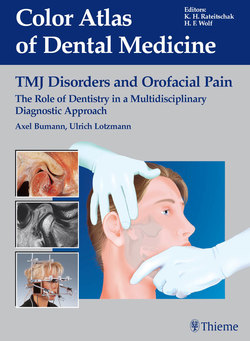Читать книгу TMJ Disorders and Orofacial Pain - Axel Bumann - Страница 7
На сайте Литреса книга снята с продажи.
ОглавлениеForeword
Dr Bumann and Dr Lotzmann are two authors with an outstanding amount of information and illustrations at their disposal. Working together with Thieme, a publisher known for its ability to communicate through the use of illustrations, to produce this book has proven to be a perfect collaboration.
Imaging can play an important role in the diagnostic and treatment processes associated with orthodontic, restorative, and craniomandibular disorder patients, because finding the correct diagnosis is crucial for the development of the optimum treatment strategy as well as for the application of the appropriate treatment. This book illustrates successfully a range of complex anatomic conditions involving the maxillofacial structures through the clever use of high-quality illustrations and diagnostic images.
Nevertheless, rather than recommending diagnostic imaging as a routine procedure, the authors correctly point out that diagnostic imaging is best applied when there is a likelihood of benefiting the patient. The potential value of the use of imaging for a patient is most often determined during the physical examination and history taking. To achieve the full value of diagnostic imaging, the clinician is required to develop specific imaging goals, to select the appropriate imaging modalities, to develop an imaging protocol, and to interpret the resultant image(s). The ideal imaging solution is one which meets the clinically derived imaging goals white maintaining the lowest achievable patient risk and patient cost. The authors discuss and illustrate the most common imaging modalities available today.
Dr Bumann and Dr Lotzmann applied a “systems” approach to facilitate understanding of the functional or biomechanical relationships between the craniomandibular structures, including the jaws, teeth, muscles, and temporomandibular joints. This type of approach would seem to be a must for all clinicians interested in the restoration of occlusion or in the diagnosis and management of selected craniomandibular disorders.
This textbook illustrates a wide range of maxillofacial, musculoskeletal, and articular conditions that may be associated with crandiomandibular disorders. I was intrigued by the proposed functional analysis which produces selected diagnostic data about intracapsular conditions of the temporomandibular joints that until now have been the exclusive domain of diagnostic imaging.
The authors have created a well-illustrated textbook, detailing many of the biomechanical aspects of craniomandibular disorders. The imaging portions alone would make this a valuable reference text for all practitioners trying to understand or diagnose patients with craniomandibular disorders.
David C Hatcher. DDS. MSc, MRCD (c)
Acting Associate Professor
Department of Oral and Maxillofacial Surgery
University of California San Francisco
San Francisco, CA
